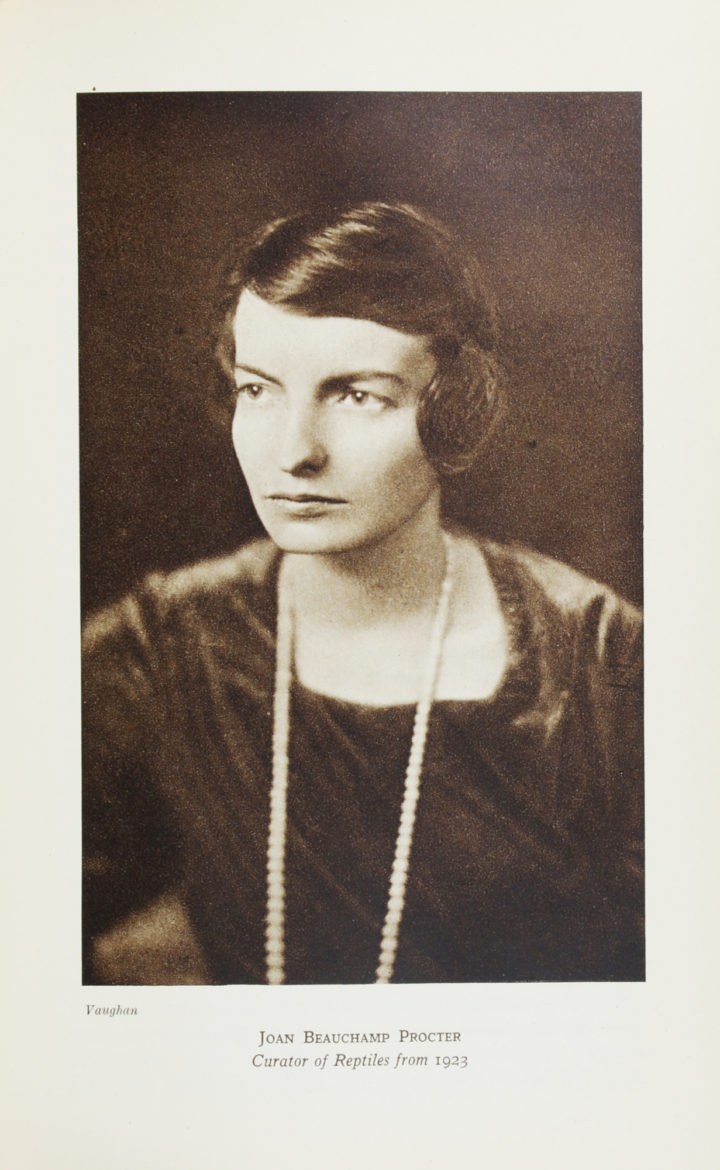Joan Beauchamp Procter FLS
Published on 8th March 2019

One of the most brilliant naturalists in Great Britain
This International Women’s Day we recognise one of our Fellows, Joan Beauchamp Procter. Born in London on the 5th August 1897 to Joseph Procter, a stockbroker, and Elizabeth Procter, an artist. Her grandfather William Brockbank was a lover of art and also an amateur botanist and geologist. Both Joan and her sister Chrystabel Prudence Goldsmith Procter (1894–1982) grew up in a family interested in both art and sciences.
We were both pushed into exactly the right cause by heavy misfortune… yet herpetology and horticulture were quite definitely what Joan and I were born to study.
Joan studied at St Pauls’ School for girls, intending to go on to the University of Cambridge. Unfortunately her chronic illness stopped her from pursuing her studies at Cambridge, although that didn’t stop her altogether. She was known to be passionately devoted to the study of animals from a young age. According to Chrystabel they kept at home lizards, snakes and even once a baby crocodile in their bath, even though their father disliked reptiles.
She preferred a large green Dalmatian lizard as a plaything instead of dolls.
She became good friends with Dr G. A. Boulenger FRS, the distinguished authority on reptiles at the time, after visiting him numerous times at the British Museum to talk about specimens. In 1917 she started working at the museum and by 1920 was in charge of the reptile department.
On the 21st of June 1923 she was elected Fellow of the Linnean Society. 1923 was also the year she was appointed curator of reptiles at the Zoological Society of London to replace Mr Boulenger, Dr Boulenger's son, who was appointed Director of the new aquarium. Once appointed she really turned the reptile house around. Instantly recognising the old reptile house as a ‘pest-house’ and a constant stream of ‘disease’ and ‘invading vermin’. She persuaded the council to build a new reptile house, which is still in use today. At the time is was the ‘most novel installation for the accommodation of animals that has yet been made in any country’. This included the use of ‘vita glass’, a high tech concept at the time, which allowed natural ultraviolet light to penetrate through which the reptiles highly needed.

This project was truly Joan’s own.
She had the best possible architectural and technical advice and we all assisted her in every way we could. But from the beginning it was her house.
Her hard work paid off and the reptile house, which opened in 1927 was a great success. Under these new conditions reptiles were more active, fed better and grew quicker. Also, unexpectedly creatures became more docile.
Notable instances are the Komodo dragons, which are as tame as dogs and even seem to show affection” “Some of these [large Pythons]…will allow their heads to be stroked and their mouths examined
Joan Procter was known all over the world for her work at the reptile house and also for her published work. Most famous is her study on the east African tortoise Testudo liveridgei, now called Malacochersus tornieri. Her international recognition led her to receive an honorary doctorate D.Sc. degree from the University of Chicago.
It is important to remember that in all her achievements she was suffering from a chronic illness, which led to her premature death at the age of 34 from cancer. She, however, never let her illness define her and continued to issue orders while bed ridden.
As E.W. MacBride stated "Her success was that she really loved animals. She regarded them not as reflex machines but as her younger brethren."
By Leanne Melbourne, Events and Communications Manager
References
- Proceedings of the Linnean Society of London (October 1931 to May 1932). Obituary by E.W. MacBride pp183-185
- Letter from the Linnean Society of London Archives: Proctor, Chrystabel P. G.; 1 letter, 15 Jul 1979
- Centenary History of the Zoological Society of London by P. Chalmers Mitchell, 1929
- The Zoological Society of London 1826-1876 and BEYOND, EDITED BY Professor Lord Zuckerman
